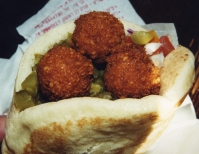In February, I joined over one hundred United Methodists from Georgia who visited the Holy Land. I am sharing my reflections about the pilgrimage in a series of journal entries.
After spending the night in Tiberius, we drove north of the Galilean Sea into the Upper Jordan Valley. We stopped briefly at the Old Testament site of Hazor—a strategic, fortified city located in the southern Hula Valley. King Solomon expanded the town to protect the region.
A large well descends over 130 feet to reach the water table. Unfortunately, most of us didn’t have time to make the descent . . . of course, this would have also required an ascent, so the shortage of time might be counted as blessing rather than curse.
The tour continued to Dan which marked the traditional northern point of Israel. In the Old Testament, Israel’s boundaries stretched from “Dan to Beersheba.” A handful of us walked up the hillside to the “high place” which archaeologists unearthed.
Following King Solomon’s death, Israel divided into two kingdoms. King Jeroboam feared the northern kingdom citizens would want to worship in Jerusalem, so he crafted two golden calves for the people to worship—one in Bethel and the other in Dan on the high place where we stood. Sigh—God’s people constantly struggle with the whole idol thing.
In a juxtaposition of ancient and modern, military trenches and a bunker on the northern end of the site overlooked Lebanon. After returning to the bus, we discovered that two Israeli soldiers were killed nearby just the week before.
We continued north to Caesarea Philippi located at the foot of Mount Hermon. The town rested beside a headwater of the Jordan River. The founders named the town Panias after the Greek god, Pan.
Pan, who inspired such words as “panic” and “pandemonium,” possessed goat legs with a human body and horned head. His temple sat in the mouth of a large cave from which the spring flowed. People claimed the deep cave served as an entrance to the underworld or Hades.
Herod the Great later ruled the region during the time of Jesus’ birth, and he renamed the city Caesarea in honor of his patron, Augustus. Herod’s son, Philipp, then egotistically added the Philippi to the name.
Matthew 16:13-20 states Jesus used the backdrop of Caesarea Philippi to ask his disciples, “Who do people say that I am?” The disciples rattled off all the rumors circulating about Jesus’ identity. Then the Lord asked, ‘But what about you? Who do you say that I am?”
In the pregnant silence that followed, Simon Peter declared: “You are the Christ, the Son of the living God.”
Jesus blessed Simon. Then perhaps gesturing to the temple dedicated to Pan, Christ said: “The gates of Hades will not overcome the church.”
Looking at the site as someone reread the Gospel account, the familiar passage suddenly gained fresh and relevant meaning. Every culture promotes gods and idols that demand worship. Against such a pantheistic setting, however, Jesus claimed the title of THE Son of God.
After Caesarea Philippi, we continued northeast up the foothills of Mount Hermon. We arrived in a Druze village clinging to the hillside for a late lunch. A large Coca-Cola sign hung outside the restaurant—Walt Disney was right: it really IS a small world.
 Out of the limited lunch options, I tried the falafel. The Middle Eastern dish consists of ground chickpeas rounded into a small ball and then deep-fried. For Southerners, imagine the size and appearance of hush puppies. The woman behind the counter shoved a half-dozen of the golf-ball sized spheres into pita bread.
Out of the limited lunch options, I tried the falafel. The Middle Eastern dish consists of ground chickpeas rounded into a small ball and then deep-fried. For Southerners, imagine the size and appearance of hush puppies. The woman behind the counter shoved a half-dozen of the golf-ball sized spheres into pita bread.
I will confess that yours truly might not qualify as a world class gourmet. I took a big bite and chewed . . . and chewed . . . and chewed some more. I’m glad I tried falafel because this means I won’t have to eat it again in the future.
Closing thought for this journal entry: Thank God for peanut butter crackers!


Maybe one day I’ll get there…thanks for sharing
LikeLike
Thanks for sharing. Seems as if you travelled with the peanut butter and biscuits. Have a blessed day.
LikeLike
I was so glad that when we had such beautiful weather on this day, because this was a lovely location. It was difficult to imagine people using it for sacrifices.
LikeLike
This journal brought back old memories. Thanks for sharing.
LikeLike
Thanks for the shout out to Coca-Cola!
LikeLike
Coke helped put my daughter through nursing school and me through seminary at Emory–always glad to testify!
LikeLike